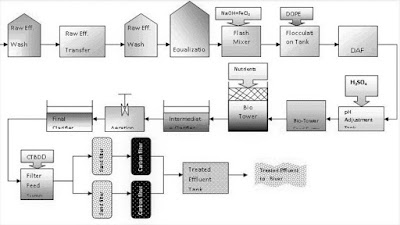Wastewater Treatment Plants
Wastewater treatment is the process of converting wastewater to remove contaminants from wastewater or sewage water that is no longer needed or is no longer suitable for use into an effluent water that can be treated to remove pollutants, converted and broken down during the treatment process before it can be released back into the local environment.
Various waste streams such as oily water, KO drum water, and sour water with sufficient pressure can be collected into a header and sent to a floating-roof waste-water tank with an oil skimmer. A combined oily-water and storm sewer will flow by gravity to an underground sump to be pumped on level control into the same floating roof tank. Hydrocarbon vapors from the sump should be collected in disposable carbon canisters to prevent escape. Skimmed oil from the tank will be removed periodically by vacuum truck and taken to a recovered oil tank for recycle.
After free oil has been skimmed, water will be pumped to a dissolved-air flotation (DAF) unit to remove dissolved oil and sediment. Oil and sludge from the DAF unit will be sent to a recovered oil tank for recycle. Vapors from the DAF unit should be processed in an odor filter unit to removed residual hydrocarbons which could cause odor complaints. Hydrocarbon vapors are absorbed in an iron sponge vessel followed by carbon beds.
DAF effluent water will be sent to a bioreactor tank for digestion of residual hydrocarbons using microbes. Bioreactor tank water will overflow into a clarifier tank for removal of sediment and biomass. Clarifier effluent water will be pumped into the local waste-water pipeline near the plant for disposal. Bottom sediment from the clarifier will be pumped into a tank for thickening and then pumped through filters. Filter cake will be dropped into a roll-off box for disposal in a land fill. Filtrate water will be recovered in a sump and pumped on level control back to the bioreactor tank. The steps described above are typical commercial waste-water treating processes.

You have achieved incredible work by dispersing this article here. I tracked down this article a ton of helpful, and besides redesigning our insight is significant. Thankful to you for sharing an article like this. Commercial Waste Collection Kent
ReplyDelete